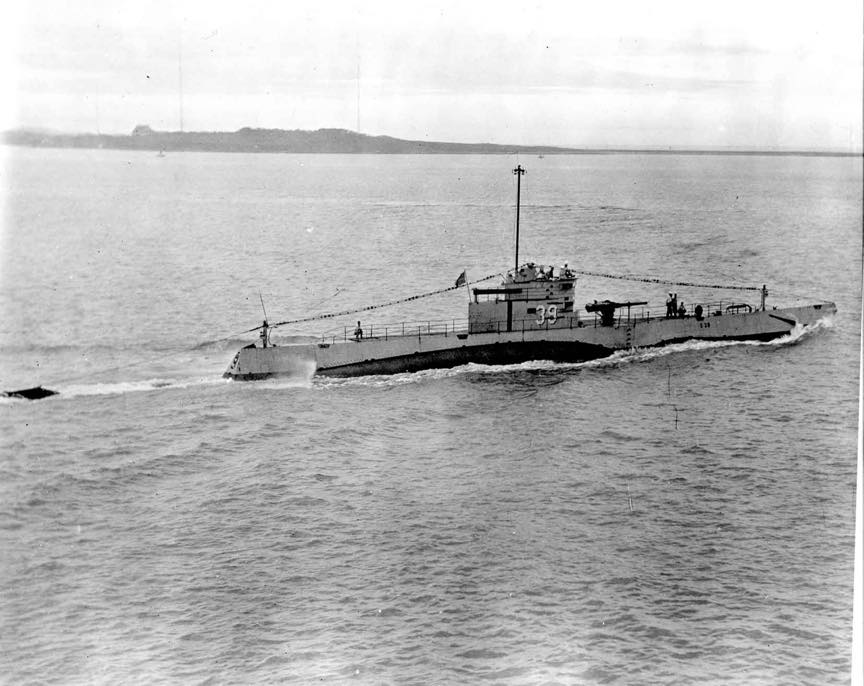
S-39
(SS-144: dp. 854 (surf.), 1,062 (subm.), 1. 219'3"; b. 20'8"; dr. 15'11" (mean), s. 14.5 k. (surf.), 11 k.
(subm.); cpl. 42; a. 1 4", 4 21" tt.; cl. S-1)
S-89 (SS-144) was laid down on 14 January 1919 by the Bethlehem Shipbuilding Corp., San Francisco, Calif., Launched on 2 July 1919, sponsored by Miss Clara M. Huber; and commissioned on 14 September 1923, Lt. J. A. Scott in command.
After commissioning and fitting out, S-89 joined Submarine Force, Battle Fleet, and, from October through December 1923, conducted maneuvers off southern California. With the next year, 1924, she moved south to the Panama Canal, thence proceeded into the Caribbean for final trials, further exercises and training dives. By April, she was back at Mare Island for her first overhaul.
On 17 September, S-39 departed San Francisco for the Philippines. Steaming via Pearl Harbor and Guam she arrived at Manila on 5 November, joined the Asiatic Fleet as a unit of Submarine Division 17 (SubDiv 17); and commenced local operations and drills in the Luzon area. In mid-May 1925, she sailed for the Asiatic mainland with her division; and, after brief stops at Amoy and Hong Kong, arrived at Tsingtao, whence she operated until early September. She then returned to Manila and for the next 16 years maintained, with few interruptions, a similar schedule: summers based at Tsingtao, with patrols along the China coast; and winters in the Philippines, for overhauls, engineering trials, joint Army-Navy maneuvers type training exercises, and short patrols.
Just prior to the entry of the United States into World War II, S-39 patrolled off southern Luzon. After 8 December, she moved into San Bernardino Strait to impede Japanese mining activities. The escorts screening the minelayers, however, kept the American submarine at bay with persistent depth charging. On the 11th, S-39 endured a day-long pounding. She then turned to a more hopeful mission, cutting into the Japanese supply line. On the 13th, she contacted and attacked an enemy freighter, but, again escorts interfered and her crew was prevented from verifying a sinking. She continued her patrol, unsuccessfully chasing other targets, until 21 December when she returned to Manila.
Increased enemy air activity soon rendered naval installations in the area untenable, and S 39 was ordered to Java to join what would become, in mid-January 1942, the ABDA command. Conducting her second war patrol en route, she arrived at Soerabaja on 24 January; underwent an abbreviated availability; and departed for her third patrol. Operating in the South China and Java seas, she reconnoitered Chebia Island, in the former sea, in search of British refugees from Singapore. Unsuccessful, she returned to the Java Sea and, on 4 March, sank Erimo, a 6,500-ton tanker. Two weeks later, she arrived at Fremantle Australia; and, by the end of April, had moved on to Brisbane, whence she departed on her fourth patrol on 10 May. During the next four weeks, she reconnoitered designated areas of the Louisiade Archipelago, then operated in the Solomons.
S-39's fifth patrol, delayed twice by mechanical failures and once by the necessity of hospitalizing her executive officer, began on 10 August. Assigned station off New Ireland, she made her way across the Coral Sea to the Louisiades. On the night of 13-14 August she grounded on submerged rocks off Rossel Island an] took on a 30° list to port. Heavy seas pounded her and pushed her farther up on the rocks. Throughout the 14th, 15-to-20-foot breakers broke over the submarine but the crew maintained its fight to refloat the ship. By the 15th, the list had increased to 60°. The heavy seas had not abated; S-89 continued to be pounded against the rocks. Efforts to evacuate the crew were begun. Lt. C. N. G. Hendrix and Chief Petty Officer W. L. Schoenrock swam ashore; secured mooring lines for use as riding lines; then assisted other crew members to safety. By noon, 32 men had reached shore. Shortly thereafter, HMAS Katoomba arrived and by the same time on the 16th had taken the entire crew of S-39 on board. S-39 was left on the rocks to continue breaking up. Her crew members were taken to Townsville and later reassigned to other submarines.
S-89 earned two battle stars for her World War II service.
